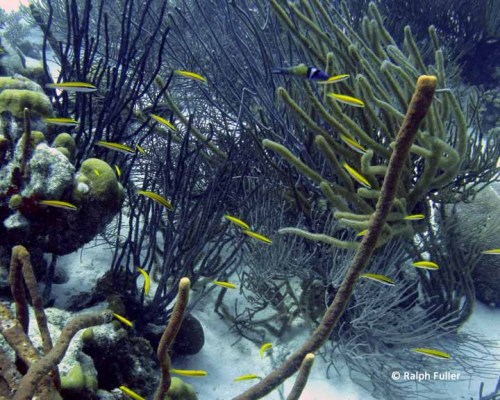
IF YOU’VE DIVED IN THE TROPICAL ATLANTIC/CARIBBEAN, you’ve almost certainly seen bluehead wrasses. Of course, most of them weren’t blue.
The blueheaded members of bluehead wrasse world are terminal-phase males, or supermales. Despite their high visibility, they make up no more than 10 percent of a given bluehead wrasse population.

The overwhelming majority of bluehead wrasses are yellow – juveniles or initial-phase adults or something in between. Blueheads (Thalassoma bifasciatum) are among those fish that go through multiple phases, with mixed features during transitions. Worse, they’re not always consistent.
ENTHUSIASTIC RAIDERS
And when you saw them, they were probably frantically darting around in packs or 20 or more, cleaning other fishes of parasites – or helping themselves to the eggs in other fishes’ nests. Most fish will raid an egg nest, but blueheads are the true fishy Pirates of the Caribbean.
Fish generally specialize in their food of choice – algae, plankton, small mollusks and crustaceans, other fishes. But most fish are opportunistic omnivores, always willing to take advantage of an easy meal. And other fishes’ eggs are apparently irresistible.
Blueheads in particular are notorious for raiding egg nests of bicolor and beaugregory damsels, sergeant majors and redlip and saddle blennies. Attacking in packs, they can overwhelm a nests’ defenders and plunder its contents in a matter of minutes.
PLANKTON FEEDERS, CLEANERS… AND PREY
In non-plundering mode, initial-phase Thalassoma bifasciatum are planktivores, picking zooplankton out of the ocean currents. They’re also frequently seen providing cleaning services to larger fish, although their constant darting and diving may make specific observation difficult.
But although they’re described as one of the most efficient cleaner fish in the Caribbean, their effectiveness is estimated to amount to only about 10 percent of cleaning on the reefs.
The reason: They tend to be preyed upon by some of the clients they clean. They’re said to avoid providing services to spotted eels, red hinds and graysbies for this reason. Other bluehead predators include soapfishes, some stingrays and trumpetfish.
It should be noted that supermales, which have developed teeth strong enough to crack hard shells, largely focus their feeding on crustaceans and mollusks they scrounge from the sandflats.

JUVENILES & INITIAL PHASE-BLUEHEADS – MOSTLY YELLOW, WITH VARIATIONS
Juveniles start out as pretty much all yellow and age into initial-phase adults that have yellow heads and backs and white undersides separated by dark bands running along each side. Sometimes the bands break into Morse-code like dashes. And, actually, blueheads that live in inshore, non-reef habitats tend to be white both above and below the dark band.
Supermales, notable for their blueheads and green bodies, may reach lengths of 9 inches or more, although in my experience four to six inches seems more common. Juveniles are likely to be seen at 1.5 to 3 inches, initial-phases at up to 3.5 inches.
In any pack of initial-phase blueheads, most are females, with the aggregations dominated by far fewer supermales. The male/female, initial-phase/terminal-phase specifics of a group will vary according to the size of the population.
Blueheads don’t have specific feeding or breeding territories but a group’s supermale makes appearances throughout the day.
GENDER TRANSFORMATION in THALASSOMA BIFASCIATUM
As with many species, bluehead wrasses are protogynous hermaphrodites – that is, fishes that can transition from female to male when conditions call for it. It’s called for by the disappearance, for whatever reason, of that particular group’s supermale.
The likely follow-up is that the largest initial-phase fish in the mix – male or female, but it’s likely to be a female – undergoes a transformation into the group’s supermale. It’s a one-way process.

THALASSOMA BIFASCIATUM REPRODUCTION
Once established as the supermale in charge, the new honcho gets busy producing more bluehead wrasses. Actually, they pretty much all do, each in their own way.
Despite their penchant for raiding other fishes’ egg nests, blueheads are broadcast spawners, casting their gametes in groups into the water column, skipping any nesting.
Sometime at midday, they all head off to rendezvous points on the reef. Specifics may vary depending on the population size, but they are all broadcast spawners, releasing their gametes into the water column together.
Generally, supermales head to favored locations and spawn in pairs with specific initial-phase females, doing so repeatedly with numerous partners. As for the rest of the population, initial-phase males and females take part in broadcast spawning with in large aggregations at different sites.

BLUEHEAD WRASSES’ JOURNEY
Fertilized eggs are carried off with the currents, never to see their parents again. Once hatched, bluehead larvae spend six to eight weeks drifting with the currents. Upon settling into shallow-water habitats, the larvae bury themselves in the sediments and spend several days transitioning into juveniles. Eventually, they emerge to join a nearby population as initial-phase wrasses.
PRINCIPAL SOURCES: Reef Fish Identification Florida, Caribbean, Bahamas, Paul Humann, Ned DeLoach; Reef Fish Behavior, Ned DeLoach; Peterson’s Field Guide to Atlantic Coast Fishes, C. Richard Robins, G. Carlton Ray, John Douglass; “Thalassoma bifasciatum,” Encyclopedia of Life; “Thalassoma bifasciatum,” University of Florida Museum of Natural History.
